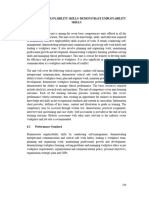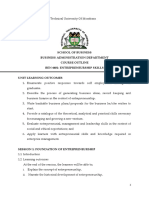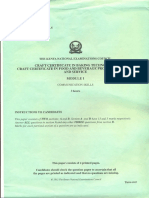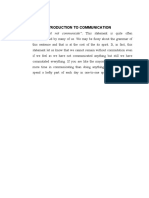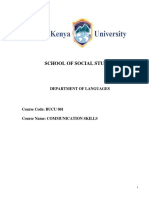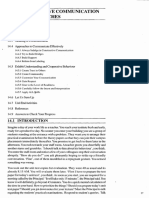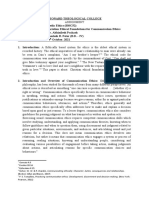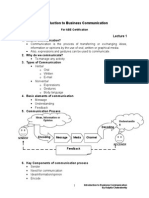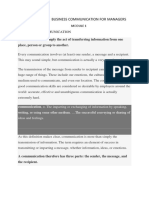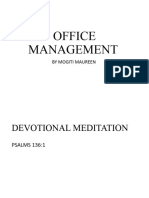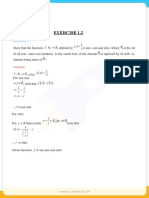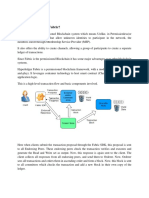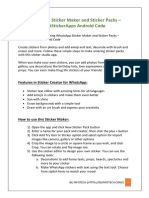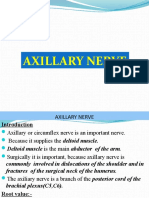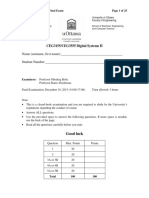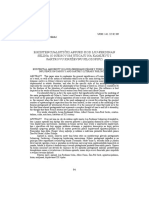SECRETARIAL TRAINING PROGRAMS
COURSE OUTLINE
Prepared by: Center of Training and Consultancy of SIMAD University
Oct 2011
�Course Contents
Modules Module A Title 1. Organizational Skills and Filing Contents 1. Office Documentation 2. Storage of Documentation 3. Desk and Diary 4. Working on Different Stations 5. Meetings Page
2. Filing
Qualities of filing 2.System of filing 3.Systems of filing; central filing, departmental filing, alphabetical filing, numerical. 4.Advantages and disadvantages of vertical filing. 5.Advantages and disadvantages of lateral filing. 6.General Rules. 7.5 Steps to successful filing.
1. 8.
3. Telephone Skills
1. Introduction. 2. Telephone techniques in detail. 3. Before you answer the phone. 4. Whilst answering the phone. 5. In the course of the conversation. 6. When concluding the call. 7. When transferring the call. 8. Making a call. 9. Slang expressions vs Correct expressions 10. Difficult situations. 11. Dos and Donts.
Prepared by: Center of Training and Consultancy of SIMAD University
Oct 2011
�4. Communications skills
1. Methods of communication: telephone, e-mail, letter, internal memo, fax, meeting, conference and presentations. 2. The 4 basic elements of the communication process: sender, message, medium and receiver. 3. Internal and external communications. 4. Basic types of communication: written, verbal and non-verbal. 5. Types of written communication and its advantages and disadvantages. 6. Types of verbal communication and its advantages and disadvantages. 7. Types of non-verbal communication and its advantages and disadvantages. 8. Problems in communication.
Module B
1. Minute Taking
1. Definition of minutes 2. The Agenda 3. Types of minutes: resolution and narrative minutes. 4. Taking notes 5. Writing the minutes 6. Circulation of minutes 7. Conclusion 8. Practical examples of Minutes and Agenda.
Prepared by: Center of Training and Consultancy of SIMAD University
Oct 2011
�2. Business Letter Writing
Module C
1. Keys to writing Effective Business Letters. 2. The Seven Cs of Business Letter Writing. 3. Common errors in Business Letters 4. Examples of : Starting a letter, the reference, reason for writing, requesting, Agreeing to requests, giving bad new, enclosing documents, closing remarks, reference to future contact and the finish. 3. Time Management 1. Introduction 2. Working ones long term priority. 3. Planning Tasks. 4. Allocating Time. 5. Various points to remember. 6. Booking Quiet Time. 7. Useful tips 8. Being Realistic 9. Clearing your office and projecting an image. 10. Processing documents. 11. Golden rules. 1.0 Handling Conflict and Handling difficult Stress customers. Handling ColleagueRelated stress subdivided into six categories: The Chatty Neighbor The Slanderer The Best Friend The Thief The Clinger The Secret Agent 2.0 Basic Accounting Basic definitions of Concepts debtor and sales/turnover. Basic definitions of debtor and sales/turnover Basic definitions of creditors and purchases 4
Prepared by: Center of Training and Consultancy of SIMAD University
Oct 2011
�3.0 Other Duties
Secretarial
Assets: subdivided into Fixed Assets and Current Assets Liabilities subdivided into Long Term Liabilities and Current Liabilities Share Capital, Balance Sheet and Profit and Loss account. Invoice Cash book : receipts and payments Mark up and Margin Shares and shareholders Directors Interests, dividends and bonds Audited Financial Statements Audit and Cash flow projections Stationery stock and its control. Petty Cash and the Imprest system. Travel arrangements for staff and/or superiors
Module D
Practical Sessions in basic WORD, EXCEL and POWERPOINT
Prepared by: Center of Training and Consultancy of SIMAD University
Oct 2011
�MODULE A
1.
OFFICE ORGANIZATIONAL SKILLS
Organizational skills are important for your day after day office work because they will assist in planning correctly the actual projects which must be completed. At this time there are various sorts of training programs for organizational skills which really need to be discovered for a more effective arranging as well as to guide you a comfortable lifestyle. Organizing is definitely an essential component of such training programs. Organize your own work and work your plan is a typical declaring that most of people should have noticed, however only the individuals that have really applied this in their everyday program understand how necessary the idea to plan everything.
1.1
OFFICE DOCUMENTATION
1.2
OFFICE FILING SYSTEM
Introduction Definition: Filing System involves classifying, arranging and storing records in a logical and systematic way. Proper Filing is becoming an important activity in todays business world. The performance of the organization is being determined more than ever before by the quality of information available for managers to make decisions. Filing is also becoming increasingly complex due to the growing amount of paperwork which businesses have. The filing systems that are adapted have to cope with these trends in the most efficient ways. In this regard, most businesses are paying more attention to the way they handle and store their information. Modern methods of filing are replacing the traditional ones and where this is not possible then upgrading of past methods is being carried out. Computerization and microfilming are two popular methods that are increasingly being used in most big organizations.
Prepared by: Center of Training and Consultancy of SIMAD University
Oct 2011
�1.2.1
FILING EQUIPMENT
There is a variety of filing equipment which is in use in the offices it includes cabinets, box files, trays 1.2.1.1 Filing Cabinets A cabinet is a cupboard or case with drawers or shelves for displaying articles, e.g. documents cabinets are usually made of steel or wood. The files in the cabinet may be kept in pull-out drawers, stored on shelves or suspended side by side. 1.2.1.2 Box Files
These are folders for holding loose papers. They are shaped like a box. Some are fitted with springs or clips that hold the papers firmly. In most cases, the boxes fitted with dust-proof covers.
1.2.1.3 Office Trays
This is a temporary storage vessel where documents are kept awaiting filing. Trays are made of wood, metal, plastic or mesh.
1.2.1.4 Office Safes
These devices are usually made of steel. They are usually fireproof. Documents that are stored such in strong devices are usually very important to an organization.
1.2.2
THE ROLE OF FILING IN AN OFFICE
A lot of information produced in an organization is in paper form. Important information has to be organized and stored for future reference. This is referred to as filing. It is the responsibility of the office to ensure that records of the organization are well kept. Filing fulfils various functions in an organization. Below are some of the benefits of filing:1. It ensures that documents are kept in a logical and systematic manner so that they can be accessed easily when the need arises. 2. The documents are put together and kept in a central place this ensures that the office appears tidy. It also becomes easy to get information that may be required. 3. It ensures that information is preserved for future reference. 4. By using a proper filing system, space which most of the time is limited is used more economically. 5. Records can be used as evidence in case of disputes. Prepared by: Center of Training and Consultancy of SIMAD University
Oct 2011
�6. The preserved documents can be used when planning by comparing the past performance with the current situation.
1.2.3
ESSENTIAL OF A GOOD FILING SYSTEM
The Saying Information is power means that those can access information easily and quickly have a competitive edge in office. In Todays competitive environment, the backbone of every business operation is information. However, the backbone of every business operation is information. However, this information has to be organized for easy access. A good filing system should facilitate fast and efficient decision making by providing information when it is required. For a filing system to be effective, it has to have the following features:1. Accessibility. The filing system should facilitate easy and fast retrieval of information
so that when records are required they can be found immediately.
2. Simplicity. The filing system is adapted should be easy to operate and understand. A
complicated system is more likely to create confusion hence delay the process of getting information.
3. Adaptability. The filing system should be flexible in order to suit the changing needs
of the organization. It should also be able to cope with any expansion of the organization.
4. Security. The filing system should be able to ensure documents are well protected
from natural hazards or unauthorized people.
5. Suitability. The system chosen should suit the needs and requirements of the
organization.
6. Economy. The filing system should be one that can be operated at minimal costs in
terms of labor, consumables, e.g. stationery, and overheads. The system should also not take up too much floor space.
7. Cross-referencing. It should be easy to locate related documents using the system.
Documents that have to be taken out should be recorded and signed for.
Prepared by: Center of Training and Consultancy of SIMAD University
Oct 2011
�1.3
OFFICE COMMUNICATION SKILL
1.3.1. Introduction Definition: Communication is the act of any natural or artificial means of conveying information or giving instructions. Communication means to provide required information to the concerned persons. In business organization, the up to date information must be available all the time regarding the various aspects of the organization. This information must be provided in time to the staff members, the customers and other interested organizations. The efficiency and success of an organization depends mainly on its communication system. Poor communication may result in loss of business of millions of shillings, loss if customers and it can spoil the good image of that organization. All communications have to be originated, produced transmitted, received and understood. The main aspects of communication to consider are: i. The source of communication i.e. the sender; ii. The contents of communication; iii. The process by which communication is produced e.g. dictation and typing; iv. The method by which the communication is transmitted e.g. letter, telephone, telex; v. Procedures involved in receiving communication e.g. mail handling distribution; vi. The destination of communication i.e. the recipient. vii. The understanding of the communication by the recipient.
1.3.2 Types of communication Communication may be broadly classified into two major:(a) Internal communication (b) External communication Internal communication refers to exchange of information or messages between persons and departments of the same organization, e.g. the communication between the employees and the communication between a company and its shareholders. External communication refers to exchange of information or messages between a particular organization of office and outside persons and organizations, e.g. Communication with customers and suppliers, and other business organizations. 9
Prepared by: Center of Training and Consultancy of SIMAD University
Oct 2011
�1. On the basis of Direction of Flow Internal communication flows into different directions according to the organization structure and need of the enterprise. Basically, three directions of flow are identified: downward, Upward and Horizontal. A. Downward Flow The flow of communication moves downward, from superiors to subordinates at different levels of organization through this flow, management plans, decisions and directives are communicated to lower levels for implementation. B. Upward Flow It denotes flow or movement of information upward, from the lowest level to the highest level of the organization, i.e., from the subordinates to superiors. Through this flow feedback information moves from lower to higher levels in the form of reports, suggestions, complaints, etc. C. Horizontal Flow The type of flow may be lateral or diagonal. Communication may take place laterally between persons on the same level of organizational hierarchy (say, supervisors of two sections) in the department. It may also take place diagonally between managers or supervisors of separate departments or between persons on different levels of hierarchy, cutting across departmental, barriers. 2. On the basis of Relationship On this basis, communication may be formal or informal. A. Formal Communication If follows the channels of formal relationships of authority and responsibility in the organization structure. Communication take place between different levels of hierarchy strictly according to the formal organization relationships established by management. B. Informal Communication This is quite often described as grape-vine. It take place between persons or groups at the same of different levels of hierarchy on the basis of informal relationships. Information passes informally between persons or groups as they come in contract with each other in the course of performing their jobs. Although not officially 10
Prepared by: Center of Training and Consultancy of SIMAD University
Oct 2011
�recognized by management, it is useful in increasing the effectiveness of formal communication. 3. On the basis of Means Adapted On this basis, communication may be of two types: Oral and Written. A. Oral Communication It is the easiest and most commonly used means of communication. Communication, both internal and external, take place between persons, orally through face-to-face conversations, telephonic conversations, etc.
Prepared by: Center of Training and Consultancy of SIMAD University
11
Oct 2011
�B. Written Communication In this type, information or massages are communicated internally or externally through written media like letters reports, memoranda, etc. On the basis of Methods Used Both Oral and Written communication may be conducted through direct or manual method or mechanical method. Accordingly, oral and written communication may be classified into the following types:A. Direct Oral Communication It is the form of face-to-face communication, interview, meetings conferences, etc. B. Oral Communication my Mechanical Method Conducted with the help of various mechanical devices like telephone, speaking tubes, dictating machines, etc. C. Manual Delivery of written Messages By physical delivery of the papers through various mechanical and electronic devices like teleprinter, fax, television, etc. D. Mechanical Transmission of Written Messages Without actual delivery of the papers through various mechanical and electronic device like telegraph, teleprinter, fax, television, etc. Importance of Office Communication Communication is a vital tool of management the potentials of communication as a management tool are so great that it is difficult to recognize them but easy to understand them. Favorable dealings with outside company contacts and effective relationships within an organization depend upon communication. Without timely communication of accurate information, management cannot effectively conduct its functions of organizing, directing, controlling the activities of the neither enterprise, nor can it maintain its external relationship. One of the major functions of the office is communication. It has not only to receive record and process information, but has also communicate this information to the management to enable it to make timely decisions with regard to directing, controlling and coordinating the activities of the organization. Again, it is a function of the office communicates the managements decision to different 12
Prepared by: Center of Training and Consultancy of SIMAD University
Oct 2011
�levels of staff and outsiders. It is only through a good human relations and high morale and motivation in the organization can be maintained to ensure success of management objectives.
The following, facts indicate the importance of the internal communication:-
Prepared by: Center of Training and Consultancy of SIMAD University
13
Oct 2011
�Better Understanding Good internal communication improves the understanding, between the employer and employees. It the complaints of staff are communicated to the employers in time and in a right way then the changes of any misunderstanding becomes minimum.
Greater Efficiency The sound communication system enable to management to instruct the supervisor and subordinate staff about any change of policy. As a result, the efficiency of workers increases. Effective Co-ordination The employees can co-ordinate more effectively in the presence of good communication system. For example, if there is increase in sales, then the marketing department can inform the production department to increase production.
To Avoid Loses Proper communication system enables the employees to inform the management about any breakdown of machinery or other shortages. The management can take action in time and avoid any possible losses.
The following facts indicate the importance of external communication:-
Good Reputation The effective communication with customer and other business enterprises enable a company to establish good reputation. This increases prestige of that company. Improvement in Public Relation When company communicates with the general public to keep them informed about its activities and services then more people become interested to deal with that company.
Prepared by: Center of Training and Consultancy of SIMAD University
14
Oct 2011
�Better Business Prospects Due to good communication, company can attract more customers. The company can increase the sales of its products. Choice of Customers A company can get the information about the liking and disliking of customers. This information helps the company to produce goods according to the choice of customers.
Communication is the most strategic factors these days. Without effective communication system an organization cannot make any progress the necessary information must be provided accurately and in time. Common Barriers to Communication Communication is most effective when it moves speedily and smoothly in an uninterrupted flow. But frequently the free flow of communication breaks down due to various physical and psychological barriers. Breakdown in communication proves costly to the enterprise not only in terms of disruption of efficiencies function of the organization, but also in terms of frictions and misunderstandings among staff with consequent adverse effect on morale on morale. It is the responsibility of the office manager to quickly locate and identify the barriers causing breakdown and to take remedial measures to overcome them.
Some of the common barriers which cause breakdown in communication are briefly indicated below:1. Complex Organization Structure Channels of communication follow the formal organization structure. The more complex the organization structure, the more complex the relationship, longer the communication lines and greater the distance between the lower and higher levels in the organizational hierarchy. In such situation, the flow of communication tends to get restricted and distorted while moving through different levels of a complex structure and much of its effectiveness is lost in the process. 2. Formal and Rigid Relationships The more formal and rigid the organizational relationships, the greater the barrier to free flow of communication upward. The formal and rigid attitude taken by superiors and their reluctance to listen to suggestions of subordinates or share information with them often discourage the subordinates to communicate freely
Prepared by: Center of Training and Consultancy of SIMAD University
15
Oct 2011
�with their superiors. Free flow of feed-back information, so vital to the communication system in thereby restricted. 3. Semantic Barriers Semantics refer to meaning of language used. Often the same word is interpreted by different people in a different way according to their mental attitude and understanding. This may act medicated by the sender may not convey the same meaning to the recipient.
Prepared by: Center of Training and Consultancy of SIMAD University
16
Oct 2011
�4. Poorly Constructed Communication Often the barrier to effective communication lies in the faulty and poor construction of the communication. The contents of the message sent may be incomplete or inadequate; it may poorly organized, incoherent or couch in language not easily understood by the receiver. It will fail to convey to the receiver the full and exact sense of the message intended to be communicated. 5. Failure of the medium used Breakdown in communication may also occur due to failure of the means, methods and equipment used for communication. The means and methods used may be unsuitable for the type of message to be communicated or the equipment used may be fully or inadequate for effective transmission of the message. 6. Volume of communication Sometimes the sheer volume of information communicated may act as a barrier to effective communication. Communication of a mass of information, much of which may be unnecessary, over burden the management and delay the decisionmaking process. Moreover, overloading of the communication channels may prevent speedy transmission of really urgent and essential information. Poorly constructed message, needing clarifications back and forth, also cause overloading and reduce the effectiveness of communication. 7. Behavioral Barriers There may be other physical factors which sometimes act as barriers to communication. Some of these are: inadequate staff, faulty procedures, inaccuracy in processing and delivery of communication, loss of documents and files, failure of the staff to follow the procedure laid down etc. Measures to overcome the barrier The following are some of the measures which may be adopted by the management to overcome the barriers and maintain the effectiveness of communication;1. Steps must taken to make the organization structure straight forward and the
communication lines simple, clear and direct.
2. In place of formal and rigid relationships a climate of trust and confidence. It will
go a long way to remove the relationship barriers. Organization members must be encouraged to share information
Prepared by: Center of Training and Consultancy of SIMAD University
17
Oct 2011
�3. Communication must be well planned and well constructed. The contents of the communication should be adequate and complete the sentences logical and well organized and the language simple, clear and unambiguous.
4. The medium and method of communication should be chosen carefully to suit the
particular communication needs. The equipment and mechanical devices to be used should be carefully selected and well maintained to prevent break downs.
5. The flow of communication should be carefully regulated to maintain the
optimum flow. Careful processing will ensure that communication channels are not overloaded. 6. All efforts should be made to improve human relations within the organization. This will automatically reduce or eliminate behavioral barriers to communication by encouraging co-operation in place of friction and by improving personnel relations between management and staff.
Channels of communication
There are basically three channels of communication i.e., ways of passing on information namely oral, written and visual. Under each channel are the under each channel are the under-mentioned forms.
Oral Communication
In an Office, great deal of time is spent in communicating orally i.e., by:
Word of mouth. Face to face. Telephone.
Face to face conversation is the most natural means of communication. One of the best means of securing co-operation and resolving problems is to talk over the matter with persons concerned. Mechanical Devices which are commonly used for oral communication are listed below: Signals. Dictating Machines. Telephone.
Prepared by: Center of Training and Consultancy of SIMAD University
18
Oct 2011
�Prepared by: Center of Training and Consultancy of SIMAD University
19
Oct 2011
�The following are also the forms of oral communication:Interviewing There are many different types of formal interview, including interviews for recruitment, disciplinary action, consultation, discussion briefing, debriefing research. Training Courses Training is concerned with improving workers Skills. Such Training may include induction training, job training, and internal training schools.
Joint Consultations
This is committee composed jointly of representative of the management and the employees and its function is to promote a two-way flow of ideas and consultation. It is a face discussion.
Meeting and Conference
Business organizations hold meetings at one time or another for the purchase of discussing matters concerning the organization.
Written communication
The means of conveying a written message of memorandum consist of:
Messenger Service This is the oldest type of service and is still used widely in business. When one wants an evidence of the message sent, to an-other, a written message is sent through a messenger.
Postal Service A major portion of the communication is being done through the postal department.
Transmitters Various types of transmitters are available for communication of written messages without physical delivery of the original papers.
Internal Memorandum This is used to give written information from one officer to another officer of the same organization.
Prepared by: Center of Training and Consultancy of SIMAD University
20
Oct 2011
�Business Letters
Much of the written information in an office is by means of business letters. Parts of a business letter: Letter Paper Business firms have a heading printed on their paper. The printed heading will state the name of the company, the address, the telephone number, telegraphic address (a shortened name to be used on the telegrams), fax numbers, a description of the firms business, the our ref, and your ref, etc. The date Written on the right hand side of the page opposite the reference or slightly lower. There are two accepted forms of the date.
29th December, 2006. December 29th,2006.
The Inside address This gives the name and address of the person or firm to whom the letter is being written (the addressee) For Individuals C.M.John Esq. Mr.J.M.Kbuka. Miss J.B.Opiyo Limited Companies Most of the business letters are addressed to limited companies and no courtesy prefix is necessary. The Salutation
Prepared by: Center of Training and Consultancy of SIMAD University
21
Oct 2011
�This is the greeting part which commences the letter, and precedes the message. The usual salutation for business letters is
Dear Sir. Dear Madam
Prepared by: Center of Training and Consultancy of SIMAD University
22
Oct 2011
�The Complementary This is the closing of the letter. Business letters close with Yours faith fully through others are sometimes used. Business letter Official Letter Semi-Personal Personal - Yours faithfully - Yours truly -Yours sincerely -Very sincerely yours
Types of reports
Informal Reports Formal Reports Statutory Reports
Informal Reports These reports are prepared by individuals within an organization on special occasions e.g., a report on fire breakage etc
Prepared by: Center of Training and Consultancy of SIMAD University
23
Oct 2011
�Files are kept so that business papers and records can be found easily. Several times a day an employer may ask for papers and records that he wants immediately.
7. Telephone Skills
Telephone The telephone is used extensively in the conduct of any business, and its use is increasing. One of your principal duties as a secretary will be to answer the telephone and to provide the caller with the information he needs or to transfer the call to the executive. Frequently you will be able to screen and handle incoming calls without bringing your employer into the conversation at all. At other times, of course, an incoming call will be transferred immediately to the employer.
4.0
Handling Conflict and Stress
That office functions best where an atmosphere of real friendliness and cooperation exists among employees. Office workers should be help, giving each other whatever information is needed and doing promptly things that are asked of them so that all the work of the firm progress smoothly. You, as a secretary, should give careful consideration to all the people encountered in the office and make a genuine effort to get along well with all of them. This may mean over-looking a number of traits that are not entirely desirable in a coworker; it may mean making diplomatic suggestions to improve the whole office situation; and it certainly means adjusting your own reactions. If you can keep an office staff working together happily, you will be one of the most valued employees in the firm.
Communications skills
Prepared by: Center of Training and Consultancy of SIMAD University
24
Oct 2011
�One of the responsibilities that a secretary will often assumes is writing of many of the more routine letters that her employers work requires.
In addition to letters that are requested by the employer, there may also be letters that the secretary will take care of on her own. There may be incoming letters that deal with details with which the secretary is fully acquainted, and she is expected to handle such either completely or to the point of preparing the response for her employers signature. To be sure, you will not be asked to compose letters until your employer is confident that you can handle this responsibility with considerable ease and accuracy. Although the letters that you may handle seem to be concerned with routine matters, you must remember that they are important, for they frequently deal with details that are critical. You will also want to be sure that they reflect the best usage in modern letter writing and that they represent your company in a favorable fashion.
Prepared by: Center of Training and Consultancy of SIMAD University
25
Oct 2011




